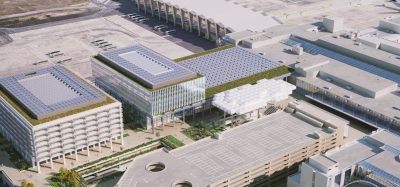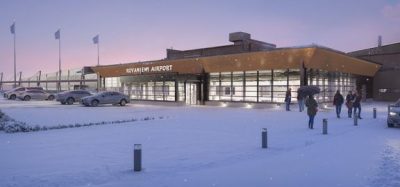Solar powered Southampton
- Like
- Digg
- Del
- Tumblr
- VKontakte
- Buffer
- Love This
- Odnoklassniki
- Meneame
- Blogger
- Amazon
- Yahoo Mail
- Gmail
- AOL
- Newsvine
- HackerNews
- Evernote
- MySpace
- Mail.ru
- Viadeo
- Line
- Comments
- Yummly
- SMS
- Viber
- Telegram
- Subscribe
- Skype
- Facebook Messenger
- Kakao
- LiveJournal
- Yammer
- Edgar
- Fintel
- Mix
- Instapaper
- Copy Link
Posted: 7 February 2012 | Steve Thurston, Head of Planning and Development, Southampton Airport | No comments yet
Southampton Airport’s vision to become ‘Europe’s leading regional airport’ has provided the motivation for a number of innovate investments in recent years. With a couple of UK firsts amongst the developments, including being the first UK airport to have solar powered LED runway guard lighting, the regional airport with the big ideas is set to continue trend setting in 2012.
For International Airport Review, Steve Thurston, Head of Planning and Development at Southampton Airport talks about solar powered LED runway guard lights, and the catalytic effect their success has had on the airport’s further development.
As the number of aircraft and vehicle movements increased within the aerodrome over the years, regular reviews of signals, signs and markings were undertaken. In Autumn 2009, Steve and his team began researching options for runway guard lights and were keen to explore the latest technology relating to sustainable products.
Southampton Airport’s vision to become ‘Europe’s leading regional airport’ has provided the motivation for a number of innovate investments in recent years. With a couple of UK firsts amongst the developments, including being the first UK airport to have solar powered LED runway guard lighting, the regional airport with the big ideas is set to continue trend setting in 2012.
For International Airport Review, Steve Thurston, Head of Planning and Development at Southampton Airport talks about solar powered LED runway guard lights, and the catalytic effect their success has had on the airport’s further development.
As the number of aircraft and vehicle movements increased within the aerodrome over the years, regular reviews of signals, signs and markings were undertaken. In Autumn 2009, Steve and his team began researching options for runway guard lights and were keen to explore the latest technology relating to sustainable products.
“We discovered that a number of airports in North America and Canada were successfully using a special model of solar powered LED lights from Aviation Renewables, specifically developed for use in higher latitudes. Given the success at other airports with a similar climate to Southampton, and our commitment to using sustainable solutions across the airport wherever possible, we were confident that we would be able to install the same lights here.”
With technology adapted from military usage and not yet widely available for commercial use, the lights also attracted interest from the CAA who worked with Southampton Airport to develop a test case. Before the full order was placed, a trial over the winter of 2009/2010 was undertaken where one light was supplied and installed.
The trial of the single Runway Guard Light Solar Series Northern Model lasted six months. During this time its brightness, reliability and ease of maintenance was tested.
“With one of the worst winters to hit the south coast in years, the lights really were put to the test,” Thurston said, “But as promised by the manufacturers, we experienced no degradation in lighting during the short, and often foggy, days, and they were 100 per cent reliable. We were also struck by the robustness and compact design of the lights making them easy to work around when maintaining the grass area surrounding them.
“Following the successful trial, we placed an order of five lights which were installed in around two weeks. Installation took place at night during non-operational hours to ensure safety and that there was no disruption to runway movements whatsoever. The units were installed on several access roads surrounding the runway, including some in the more remote areas of the airport, where there is no access to power supplies, which played a big part in our choice to use solar technology.”
Available as a Standard and Northern model, the solar series lights are designed for permanent, temporary or portable operations and can be configured with an integrated solar engine or remotely installed solar engine. They are designed for continuous 24 hour operation, require little or no maintenance and come with replaceable five to seven year life batteries.
The batteries are charged via the solar panels which then convert the energy into electricity to ensure the lights operate 24/7. The units are able to store enough energy to operate lighting for up to 120 days without any solar charging.
“Now, 16 months on from their installation, the lights are performing exactly as we expected them to and the impact they have made on the airport is wide reaching,” Thurston continued. “Their installation has enabled airside operations vehicles to move around the aerodrome safely during times of low visibility, which has increased productivity. Each light is fitted to a concrete bed in a raised position to allow maintenance of the ground around them, such as grass cutting, without any risk of damage.
“As snow is an increasing possibility even here on the south coast in the winter months, their raised position will allow for a small build up of snow, either naturally, or as a result of the use of snow ploughs nearby, without becoming obstructed.
“As was a primary objective, they have helped minimise the environmental footprint of the airport and inspired us to look at other areas where the same technology might be incorporated.
“The cost savings are already considerable as we estimated that we saved over £170,000 in installation costs by not having to lay cable to the areas of the airfield where the lights have been installed. Although we have not calculated the electricity savings, they are likely to be considerable as the battery life of the lights is good, and they aren’t likely to need to be replaced often. They are also very easy to maintain so we are not incurring additional costs there either.
“We are now looking ahead to where we can use similar technology in other areas of the airport incorporating LED lights, solar power or both where possible.
“Again working closely with the CAA we have been running a trial of LED stand lighting which has just concluded. Early in the summer we will see another UK first when we install the LED lights on all 14 of our aircraft stands. The trial proved that visibility of ground markings is better with the lights, increasing accuracy when manoeuvring aircraft and improving safety, with reports back from pilots supportive.
“Our existing lights were due for an upgrade and all wiring would have needed to be replaced, with the LED lights we have chosen this will not be necessary, so cost savings there are significant. With the installation of the LED lights there will also be a substantial reduction in running and maintenance costs in the years to come.
“Another lighting project, due for completion in February 2012, will be the installation of two solar powered LED Belisha Beacons at a pedestrian crossing close to the terminal. With no power close to the crossing, providing adequate lighting has been difficult in the past, and the darker evenings have further highlighted a need. The cost of running cables to the crossing was prohibitive, so following the success of the runway guard lights, we looked into using the same technology here. As with all our LED solar lights, on-going maintenance and running costs are minimal, so we will also be looking at their usage for other crossings on the site.
“Our experiences so far with both solar and LED lighting technology have been wholly positive and we have been happy to share our findings with the rest of the industry, directly and through our work with the CAA. Southampton Airport is committed to managing its environ – mental impact and to look for sustainable solutions whenever possible. We’re pleased to be leading the way in the UK.”
About the author
Steve Thurston, Head of Planning and Development at Southampton Airport, is responsible for developing long term airport strategies and planning stakeholder relationships in order to allow the airport to maximise its growth and value. Steve has worked for BAA at Heathrow and Southampton for eight years and before that spent 12 years with British Airways.
Issue
Related topics
Airfield lighting, Regulation and Legislation, Sustainable development

















